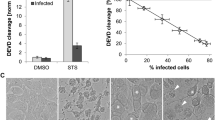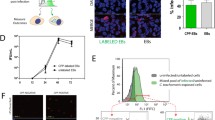Abstract
Chlamydia trachomatis-infected macrophages induce T cell apoptosis. This ability might promote intracellular survival of Chlamydia and perpetuate chronic chlamydial infection. The purpose of this study was to examine the molecular mechanisms by which C. trachomatis-infected macrophages induce T cell apoptosis. Monocytes and T cells were isolated from the peripheral blood of healthy donors. Macrophages were infected with C. trachomatis, and autologous T cells were stimulated by mitogen. After 6 days, both populations were cultured together using a two-chamber transwell membrane system to differentiate between mechanisms involving either cell-to-cell contact or secretion of apoptotic factors. Apoptotic T cells were identified by propidium iodide through-flow cytometry, and tumor necrosis factor-α (TNF-α) concentrations were measured by enzyme-linked immunosorbent assay. Antagonists of TNF-α, the Fas (CD95) molecule, TNF-related apoptosis-inducing ligand (TRAIL), and catalase were added to differentiate between the pathways of apoptosis. C. trachomatis-infected macrophages significantly induced T cell apoptosis by cell-to-cell contact (mean ± standard deviation, 30±4%; P<0.001) and by humoral mechanisms (mean ± standard deviation, 22±3%, P<0.001). Humoral apoptosis was mediated by secretion of TNF-α from infected macrophages. Inhibition of secretory TNF-α by the monoclonal anti-TNF-α antibody adalimumab (D2E7) blocked T cell death in vitro. In contrast, T cell apoptosis mediated by cell-to-cell contact was not inhibited by the different anti-apoptotic reagents. In summary, TNF-α derived from infected macrophages is an important apoptosis factor for T cell apoptosis induced by C. trachomatis-infected cells.



Similar content being viewed by others
References
Ameisen JC, Estaquier J, Idziorek T (1994) From AIDS to parasite infection: pathogen-mediated subversion of programmed cell death as a mechanism for immune dysregulation. Immunol Rev 142:9–51
Badley AD, McElhinny JA, Leibson PJ, Lynch DH, Alderson MR, Paya CV (1996) Upregulation of Fas ligand expression by human immunodeficiency virus in human macrophages mediates apoptosis of uninfected T lymphocytes. J Virol 70:199–206
Badley AD, Pilon AA, Landay A, Lynch DH (2000) Mechanisms of HIV-associated lymphocytes apoptosis. Blood 96:2951–2964
Beatty WL, Morrison RP, Byrne GI (1994) Persistent chlamydiae: from cell culture to a paradigm for chlamydial pathogenesis. Microbiol Rev 58:686–699
Beutler AM, Schumacher HR, Whittum-Hudson JA, Salameh WA, Hudson AP (1995) Case report: in situ hybridization for detection of inapparent infection with Chlamydia trachomatis in synovial tissue of a patient with Reiter's syndrome. Am J Med Sci 310:206–213
Chen W, Frank ME, Jin W, Wahl SM (2001) TGF-beta released by apoptotic T cells contribute to an immunosuppressive milieu. Immunity 14:715–725
Dalton DK, Haynes L, Chu CQ, Swain SL, Wittmer S (2000) Interferon γ eliminates responding CD4 T cells during mycobacterial infection by inducing apoptosis of activated CD4 T cells. J Exp Med 192:117–122
Darville T, Andrews CW, Rank RG (2000) Does inhibition of tumor necrosis factor alpha affect chlamydial genital tract infection in mice and guinea pigs. Infect Immun 68:5299–5305
Dean D, Powers VC (2001) Persistent Chlamydia trachomatis infections resist apoptotic stimuli. Infect Immun 69:2442–2447
Dulat HJ, Grumbkow C von, Baars W, Schroder N, Wonigeit K, Schwinzer R (2001) Down-regulation of human alloimmune responses by genetically engineered expression of CD95 ligand on stimulatory and target cells. Eur J Immunol 31:2217–2226
Earnshaw WC, Martins LM, Kaufmann SH (1999) Mammalian caspases: structure, activation, substrates, and function during apoptosis. Annu Rev Biochem 68:383–424
Engele M, Stößel E, Castiglione K, Schwerdtner N, Wagner M, Bölcskei P, Röllinghoff M, Stenger S (2002) Induction of TNF in human alveolar macrophages as a potential evasion mechanism of virulent Mycobacterium tuberculosis. J Immunol 168:1328–1337
Fan T, Lu H, He H, Shi L, McClarty GA, Nance DM, Greenberg AH, Zhong G (1998) Inhibition of apoptosis in Chlamydia-infected cells: blockade of mitochondrial cytochrome c release and caspase activation. J Exp Med 187:487–496
Fischer SF, Schwarz C, Vier J, Hacker G (2001) Characterization of antiapoptotic activities of Chlamydia pneumoniae in human cells. Infect Immun 69:7121–7129
Gérard HC, Köhler L, Branigan PJ, Zeidler H, Schumacher HR, Hudson AP (1998) Viability and gene expression in Chlamydia trachomatis during persistent infection of cultured human monocytes. Med Microbiol Immunol 187:115–120
Gérard HC, Branigan PJ, Schumacher HR, Hudson AP (1998) Synovial chlamydia trachomatis in patients with reactive arthritis/Reiter's syndrome are viable but show aberrant gene expression. J Rheumatol 25:734–743
Gerspach J, Götz A, Zimmermann G, Kolle C, Böttinger H, Grell M (2000) Detection of membrane-bound tumor necrosis factor (TNF): an analysis of TNF-specific reagents. Microsc Res Tech 50:243–250
Hammer M, Nettelnbreker E, Hopf S, Schmitz E, Pörschke K, Zeidler H (1992) Chlamydial rRNA in the joints of patients with Chlamydia-induced arthritis and undifferentiated arthritis. Clin Exp Rheumatol 10:63–66
Hirsch CS, Toosi Z, Johnson JL, et al (2001) Augmentation of apoptosis and Interferon-γ production at sites of active Mycobacterium tuberculosis infection in human tuberculosis. J Infect Dis 183:779–788
Ingalls RR, Rice PA, Qureshi N, Takayama K, Lin JS, Golenbock DT (1995) The inflammatory cytokine response to Chlamydia trachomatis infection is endotoxin mediated. Infect Immun 63:3125–3130
Jendro MC, Deutsch T, Körber B, Köhler L, Kuipers JG, Krausse-Opatz B, Westermann J, Raum E, Zeidler H (2000) Infection of human monocyte-derives macrophages with Chlamydia trachomatis induces apoptosis of T cells: a potential mechanism for persistent infection. Infect Immun 68:6704–6711
Jendro MC, Köhler L, Kuipers JG, Zeidler H (2002) Microbe-induced T cell apoptosis: subversion of the host defense system? FEMS Microbiol Lett 207:121–126
Keane J, Gershon S, Wise RP, Mirabile-Levens E, Kasznica J, Schwieterman WD, Siegel JN, Braun MM (2001) Tuberculosis associated with infliximab, a tumor necrosis factor alpha-neutralizing agent. N Engl J Med 345:1098–1104
Keat A, Thomas B, Dixey J, Osborn M, Sonnex C, Taylor-Robinson D (1987) Chlamydia trachomatis and reactive arthritis: the missing link. Lancet I:72–74
Kempeni J (2000) Update on D2E7: a fully human anti-tumour necrosis factor α monoclonal antibody. Ann Rheum Dis 59 [Suppl I]: i44–i45
Koehler L, Nettelnbreker E, Hudson AP, Ott N, Gérard HC, Branigan PJ, Schumacher HR, Drommer W, Zeidler H (1997) Ultrastructural and molecular analyses of the persistence of Chlamydia trachomatis serovar K in human peripheral blood monocytes. Microbiol Pathog 22:133–142
Koehler L, Kuipers JG, Zeidler H (2002) Persistent chlamydial infections. Biomed Prog 15:28–34
Krausse-Opatz B, Dollmann P, Zeidler H, Kuipers JG, Koehler L (2000) Frequent contamination of Chlamydia trachomatis and Chlamydia pneumoniae strains with Mycoplasma. Biological relevance and selective eradication of Mycoplasma from chlamydial cultures with mupirocin. Med Microbiol Immunol 189:19–26
Kremer L, Estaquier J, Wolowczuk I, Biet F, Ameisen JC, Locht C (2000) Ineffective cellular immune response associated with T-cell apoptosis in susceptible Mycobacterium bovis BCG-infected mice. Infect Immun 68:4264–4273
Lopes MF, Veiga VF da, Santos AR, Fonseca MEF, DosReis GA (1995) Activation-induced CD4+ T cell death by apoptosis in experimental Chagas' disease. J Immunol 154:744–752
Lopes MF, Freire-de-Lima CG, DosReis GA (2000) The macrophage haunted by cell ghosts. A pathogen grows. Immunol Today 21:489–493
Nanagara R, Li F, Beutler A, Hudson AP, Schumacher HR (1995) Alteration of Chlamydia trachomatis biologic behavior in synovial membranes. Suppression of surface antigen production in reactive arthritis and Reiter's syndrome. Arthritis Rheum 38:1410–1417
Newton K, Strasser A (2001) Cell death control in lymphocytes. Adv Immunol 76:179–226
Nicoletti I, Migliorati G, Pagliacci MC, Grignani F, Riccardi C (1991) A rapid and simple method for measuring thymocyte apoptosis by propidium iodide staining and flow cytometry. J Immunol Methods 139:271–279
Nunes MP, Andrade RM, Lopes MF, DosReis GA (1998) Activation-induced T cell death exacerbates Trypanosoma cruzi replication in macrophages cocultured with CD4+ T lymphocytes from infected hosts. J Immunol 160:1313–1319
Oyaizu N, Adachi Y, Hashimoto F, McCloskey TW, Hosaka N, Kayagaki N, Yagita H, Pahwa S (1997) Monocytes express Fas ligand upon CD4 cross-linking and induce CD4+ T cells apoptosis. A possible mechanism of bystander cell death in HIV infection. J Immunol 158:2456–2463
Perfettini JL, Darville T, Gachelin G, Souque P, Huerre M, Dautry-Varsat A, Ojcius DM (2000) Effect of Chlamydia trachomatis infection and subsequent tumor necrosis factor alpha secretion on apoptosis in the murine genital tract. Infect Immun 68:2237–2244
Roulston A, Marcellus RC, Branton PE (1999) Viruses and apoptosis. Annu Rev Microbiol 53: 577–628
Schmitz E, Nettelnbreker E, Zeidler H, Hammer M, Manor E, Wollenhaupt J (1993) Intracellular persistence of chlamydial major outer membrane protein, lipopolysaccharide and rRNA after non-productive infection of human monocytes with Chlamydia trachomatis serovar K. J Med Microbiol 38:278–285
Schnarr S, Putschky N, Jendro MC, Zeidler H, Hammer M, Kuipers JG, Wollenhaupt J (2001) Chlamydia and Borrelia DNA in synovial fluid of patients with early undifferentiated oligoarthritis. Arthritis Rheum 44:2679–2685
Seki H, Kanegane H, Iwai K, Konno A, Ohta K, Yachie A, Taniguchi N, Miyawaki T (1994) Ionizing radiation induces apoptotic cell death in human TcR-γ/δ+ T and natural killer cells without detectable p53 protein. Eur J Immunol 24:2914–2917
Stenner-Liewen F, Liewen H, Zapata JM, Pawlowski K, Godzik A, Reed JC (2002) CADD, a Chlamydia protein that interacts with death receptors. J Biol Chem 22:9633–9639
Taylor-Robinson D, Gibroy CB, Thomas BJ, Keat ACS (1992) Detection of Chlamydia trachomatis in the joints of reactive arthritis by polymerase chain reaction. Lancet 340:81–82
Telford WG, King LE, Fraker PJ (1994) Rapid quantification of apoptosis in pure and heterogeneous cell populations using flow cytometry. J Immunol Methods 172:1–16
Thiel A, Wu P, Lauster R, Braun J, Radbruch A, Sieper J (2000) Analysis of the antigen-specific T cell response in reactive arthritis by flow cytometry. Arthritis Rheum 43:2834–2842
Ward ME (1995) The immunobiology and immunopathology of chlamydial infections. APMIS 103:769–796
Weinrauch Y, Zychlinsky A (1999) The induction of apoptosis by bacterial pathogens. Annu Rev Microbiol 53: 155–187
Wesch D, Marx S, Kabelitz D (1998) Monocyte-dependent death of freshly isolated T lymphocytes: induction by phorbolester and mitogens and differential effects of catalase. J Immunol 161:1248–1256
Wolf BB, Green DR (1999) Suicidal tendencies: apoptotic cell death by caspase family proteinases. J Biol Chem 274:20049–20052
Zychlinski A, Sansonetti P (1997) Perspectives series: host/pathogen interactions. J Clin Invest 100:493–495
Acknowledgements
Our work was supported by grants from the Bundesministerium für Bildung und Forschung 01 G/9950, the European Community BIOMED BMH4-CT-98-3605 and the Medical School Hannover HILF 19311022. We appreciate the laboratory work of Mrs. Schmidt and thank Dr. H. Kupper, Abbott GmbH (Ludwigshafen, Germany), for kindly providing us with adalimumab; Dr. C. Fiehn (Medizinische Poliklinik, Heidelberg) for rIL-2 and Prof. R. Schwinzer (Medizinische Hochschule Hannover) for the Fas ligand-transfected cell line 293h and Dr. Kessels and Prof. Linde from the bloodbank of the Annastift (Hannover, Germany) for the buffy coats from healthy donors.
Author information
Authors and Affiliations
Corresponding author
Rights and permissions
About this article
Cite this article
Jendro, M.C., Fingerle, F., Deutsch, T. et al. Chlamydia trachomatis-infected macrophages induce apoptosis of activated T cells by secretion of tumor necrosis factor-α in vitro. Med Microbiol Immunol 193, 45–52 (2004). https://doi.org/10.1007/s00430-003-0182-1
Received:
Published:
Issue Date:
DOI: https://doi.org/10.1007/s00430-003-0182-1




